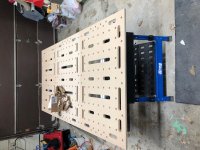Mike Goetzke
Member
- Joined
- Jul 12, 2008
- Messages
- 1,133
I previously owned almost everything Eurekazone had to offer – including an EZ-One bench. We’ll, I’m getting older now and didn’t want to mess around adjusting things as much as I used them. So about a year ago I decided to sell/give-away almost all of my EZ and purchase a Makita cordless track saw kit that came with a 55” rail, 4-batteries, and added a 118” rail. For extra depth of cut I also picked up a TS75 that came with a 75” rail.
Now that I moved from EZ I started visiting the FOG more often. The MFT benches perked my interest since I was used to working off my EZ-One but they seemed a little on the small size. Plus I need something that can easily be assembled and knocked down and stored.
I became determined to make a multi-slab bench.
I have two Kreg Mobile Project Stations (fancy sawhorses) that I use quite often even for non-woodworking projects. I was wondering if others had designed slab tops to go between two of these.
Sure enough I found what I was looking for on the Kreg user forum – TrackTubes! You can search them on the FOG too but they are basically an aluminum extruded 2x4 with a t-track on the top. I bought a set of 90” long tubes.
I decided to go with three tops 32”x48” so I could have either a 32”x96” two slab table or 48”x96” three slab table. Plus you can get all three from one 4’x8’ sheet of MDF.
Looked over many-many MFT type slab designs, made several iterations myself with my simple 2-D CAD program, and finally came up with something that I hope would work well for cutting, assembly, and my other projects.
Was set to purchase the Parf drilling system but they were out-of-stock and wouldn’t be available for some time I started looking for a local CNC router supplier. Many suggest going this rout anyway. I found one less than a mile from my house.
I’m new to working on an MFT style table and have some questions:
Hole size??? Found many suggestions and drew them up as 20.1mm (0.791”) but my CNC guy was kind enough to bore six holes in decreasing diameters of 0.oo1” since the 0.0791” was too loose for the dogs. Ends up 0.787” worked best for my dogs and his machine (snug fit yet could be removed).
Seal Top??? I see some use poly/Waterlox/Shellac then wax it. Suggestions here appreciated.
Edge Banding??? My tops will be removed and then stored on a cable lift rack. Should I edge band them with wood?
Kerf cut through top or not??? Some just cut through some say they used a thing sheet stock underneath to prevent cutting the top and some seem to use foam board. Like to hear from experienced users what they like best.
Cutting Guides??? I recently purchased a TSO GRS-16 PE. I also have a parallel edge guide for the this square. With the MFT style top would you: use the square/parallel edge guide, bench dogs, or combination of both?
Thanks,
Mike
Now that I moved from EZ I started visiting the FOG more often. The MFT benches perked my interest since I was used to working off my EZ-One but they seemed a little on the small size. Plus I need something that can easily be assembled and knocked down and stored.
I became determined to make a multi-slab bench.
I have two Kreg Mobile Project Stations (fancy sawhorses) that I use quite often even for non-woodworking projects. I was wondering if others had designed slab tops to go between two of these.
Sure enough I found what I was looking for on the Kreg user forum – TrackTubes! You can search them on the FOG too but they are basically an aluminum extruded 2x4 with a t-track on the top. I bought a set of 90” long tubes.
I decided to go with three tops 32”x48” so I could have either a 32”x96” two slab table or 48”x96” three slab table. Plus you can get all three from one 4’x8’ sheet of MDF.
Looked over many-many MFT type slab designs, made several iterations myself with my simple 2-D CAD program, and finally came up with something that I hope would work well for cutting, assembly, and my other projects.
Was set to purchase the Parf drilling system but they were out-of-stock and wouldn’t be available for some time I started looking for a local CNC router supplier. Many suggest going this rout anyway. I found one less than a mile from my house.
I’m new to working on an MFT style table and have some questions:
Hole size??? Found many suggestions and drew them up as 20.1mm (0.791”) but my CNC guy was kind enough to bore six holes in decreasing diameters of 0.oo1” since the 0.0791” was too loose for the dogs. Ends up 0.787” worked best for my dogs and his machine (snug fit yet could be removed).
Seal Top??? I see some use poly/Waterlox/Shellac then wax it. Suggestions here appreciated.
Edge Banding??? My tops will be removed and then stored on a cable lift rack. Should I edge band them with wood?
Kerf cut through top or not??? Some just cut through some say they used a thing sheet stock underneath to prevent cutting the top and some seem to use foam board. Like to hear from experienced users what they like best.
Cutting Guides??? I recently purchased a TSO GRS-16 PE. I also have a parallel edge guide for the this square. With the MFT style top would you: use the square/parallel edge guide, bench dogs, or combination of both?
Thanks,
Mike

